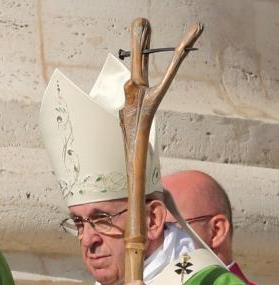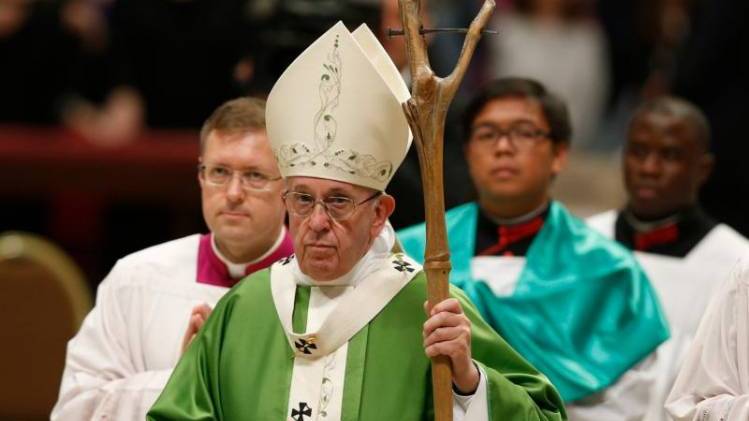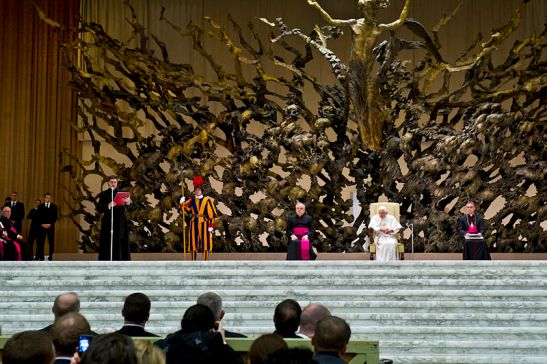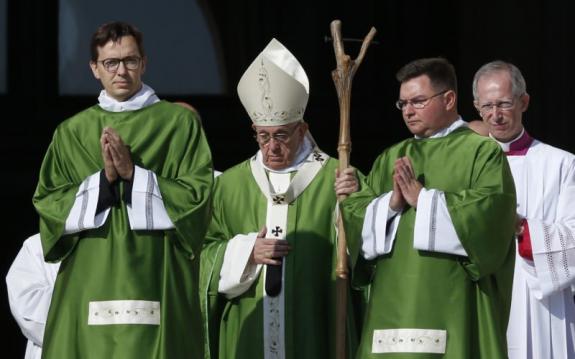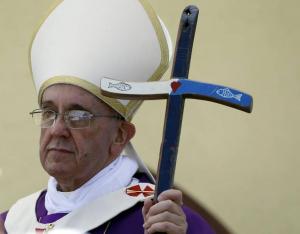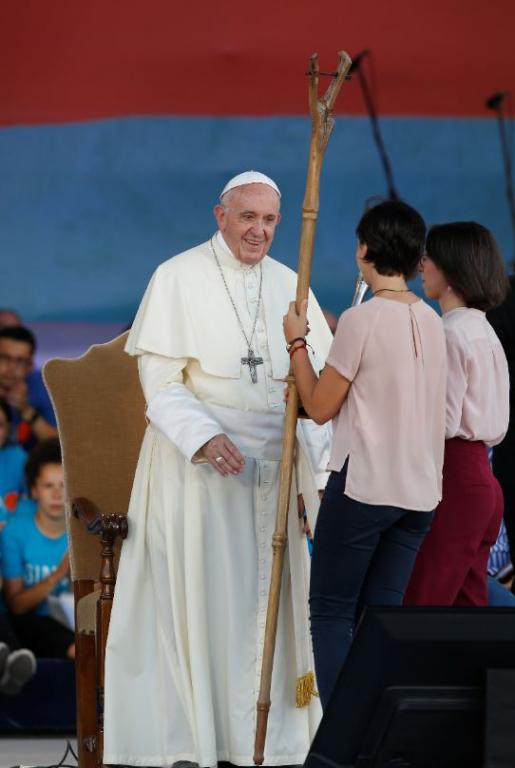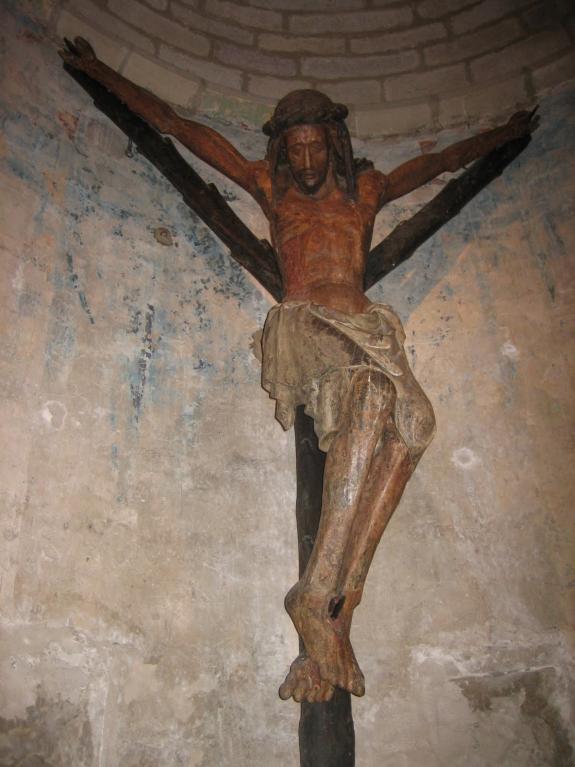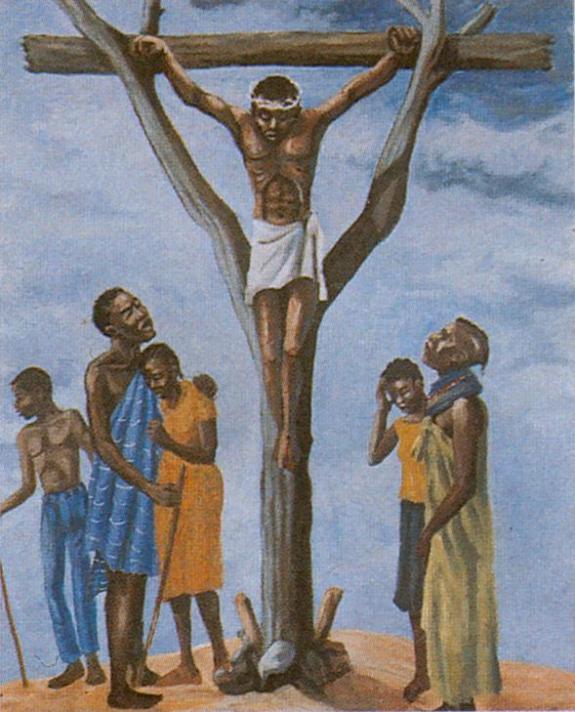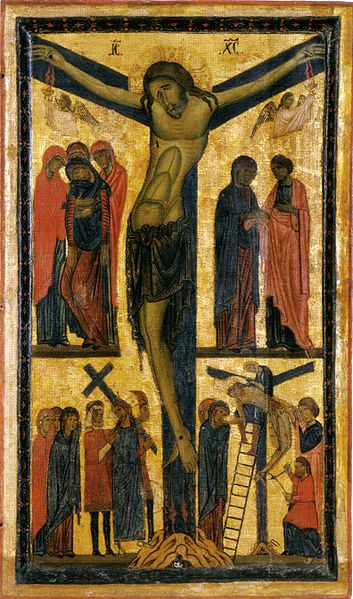
What Is the Meaning of Pope Francis’s New Gesture?
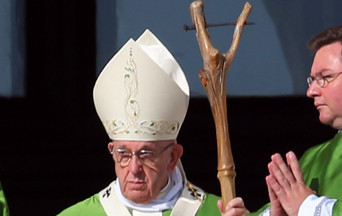
MUST READ:
A simple , humble Jesuit, Give me a break!!! Since when have Jesuits been simple : Jorge Mario Bergoglio, now Pope Francis, known for simplicity and conservatism
http://watchmanafrica.blogspot.com/2013/03/a-simple-humble-jesuit-give-me-break.html
A Jesuit Becomes the Pope of Rome: Unveiling what lies inside the pope curtain
https://watchmanafrica.blogspot.com/2013/03/a-jesuit-becomes-pope-of-rome-unveiling.htmlThe Bent Cross Crucifix versus the Traditional Crucifix
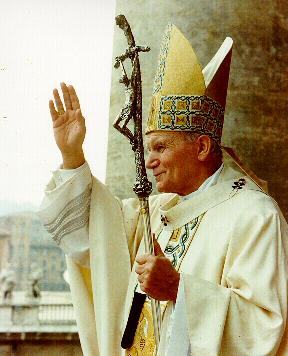
Please notice the Crucifix that Pope John Paul II is
holding up to the people, at left. Study it closely, and you will
realize that it is not a Traditional Crucifix, as we show below. Rather,
this Crucifix is known as a "Bent Cross". But, what does that mean? For
the answer to that question, let us turn to a Roman Catholic author,
Piers Compton, writing in his book, "The Broken Cross: Hidden Hand In
the Vatican", Channel Islands, Neville Spearman, 1981.
This Bent Crucifix is "... a sinister symbol, used by Satanists in
the sixth century, that had been revived at the time of Vatican Two.
This was a bent or broken cross, on which was displayed a repulsive and
distorted figure of Christ, which the black magicians and sorcerers of
the Middle Ages had made use of to represent the Biblical term 'Mark of
the Beast'. Yet, not only Paul VI, but his successors, the two
John-Pauls, carried that object and held it up to be revered by crowds,
who had not the slightest idea that it stood for anti-Christ." (p. 72)
On page 56 Compton prints a picture of the current Pope, John Paul II,
holding this bent or broken cross, just as we have shown, at left.Therefore, Pope John Paul II is telling all the occultists the world over that he is not a Traditional Pope, but a Pope that is committed to carrying out the role of World Religious Leader as called for in the New World Order Plan. Another Roman Catholic author, Malachi Martin, makes this same claim - that Pope John Paul II is committed to the New World Order Plan in his book, "The Keys To This Blood".
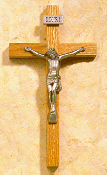 Since a picture is worth a thousand words, we have printed the
Traditional Crucifix, to the right. As you can see, the cross here is
not bent in any way, top or bottom. Further, the picture of Jesus Christ
is a full figure without any kind of distortion or disfiguration! The
Traditional Roman Catholic Crucifix is very, very different from the
"Bent Cross", above.
Since a picture is worth a thousand words, we have printed the
Traditional Crucifix, to the right. As you can see, the cross here is
not bent in any way, top or bottom. Further, the picture of Jesus Christ
is a full figure without any kind of distortion or disfiguration! The
Traditional Roman Catholic Crucifix is very, very different from the
"Bent Cross", above.We Protestants have always objected to the Traditional Crucifix, because it holds Jesus Christ up to continual shame, which is forbidden in Hebrews 6:6. Indeed, this is the basis upon which we Protestants object to the entire Mass, but that is the subject of another article.
As you can see, the Crucifix which Pope John Paul II is holding up to adoring crowds is not the Traditional Crucifx, but is the Satanic Bent, or Broken, Cross! This Bent Crucifix was created by Satanists to depict Antichrist and his Mark of the Beast! Very soon, you will see the appearance of a global leader, calling himself The Christ, who will claim to be Jesus Christ returned, the Jewish Messiah, and the Avatar figure for which all the major religions are awaiting, all in one man. This will be Antichrist. Then, very quickly thereafter, a global religious leader will step forward to aid the Antichrist; this religious leader will possess the same miraculous power of Antichrist. At this moment, the prophecy of Revelation 13:11-14 will be fulfilled; this global religious leader will be the Biblical False Prophet.
The New World Order Plan calls for this global religious leader [False Prophet] to be the Roman Catholic Pope, whomever he is at the time; certainly, John Paul II's use of this Satanic Bent Cross is consistent with this part of the Plan.
You have been forewarned. A picture is worth a thousand words, and this Bent Cross picture labels Pope John Paul II and the Roman Catholic Church.
To see other obvious Satanic symbols being openly used by the Roman Catholic Church, click here.
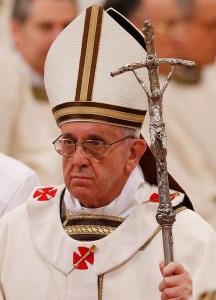
N.B :THE ARTICLES BELOW ARE CATHOLIC SOURCES
What Is the Meaning of Pope Francis’s New Gesture?
https://www.tfp.org/what-is-the-meaning-of-pope-franciss-new-gesture/
October 17, 2018 | Luiz Sérgio Solimeo
© Franco Origlia/Getty Images News/Getty Images
However, at the inauguration of the Youth Synod, on October 3, the Holy Father presented himself with a new papal ferula: a forking bamboo-like staff. The cross disappeared.
Paying close attention, one notices a carved face at the base of the fork, which would be Our Lord’s. According to some, the fork is supposed to represent the arms of the Savior.
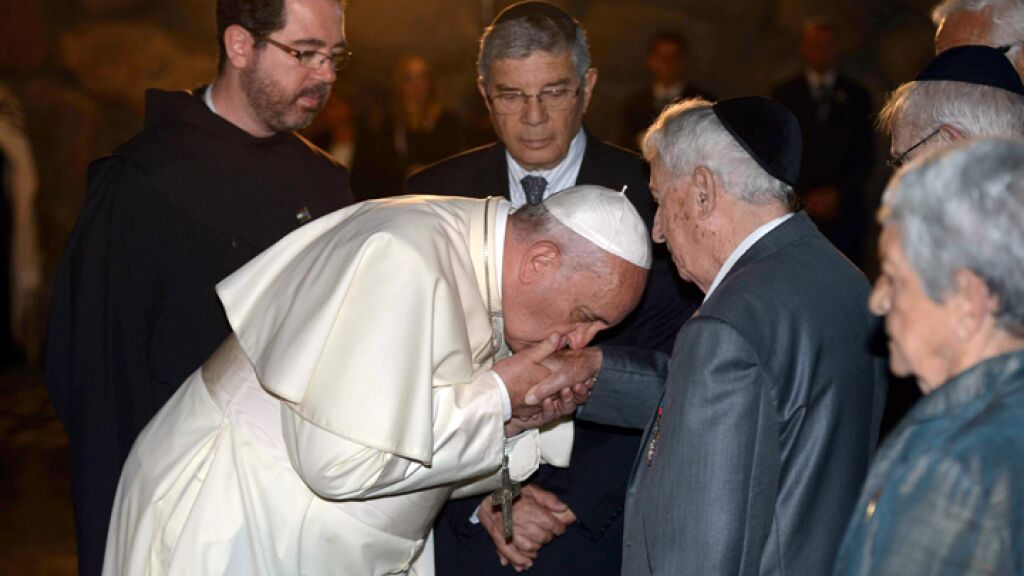
This new symbol aptly suits the kind of religion you see in photographs of this meeting: countless boys appear shirtless, and girls without a blouse, wearing only a revealing bra and tight shorts.1
Back to the new symbol used by Francis, which caused no small commotion in the Catholic world,2 this aberrant replacement of the cross with a fork has even more serious aspects.
The staff topped by a fork is related to witchcraft and Wicca, and in the United States, it is called a stang. Significantly, one of the girls who delivered the staff to Francis wore a “red string on the wrist . . . something from Wicca.”3

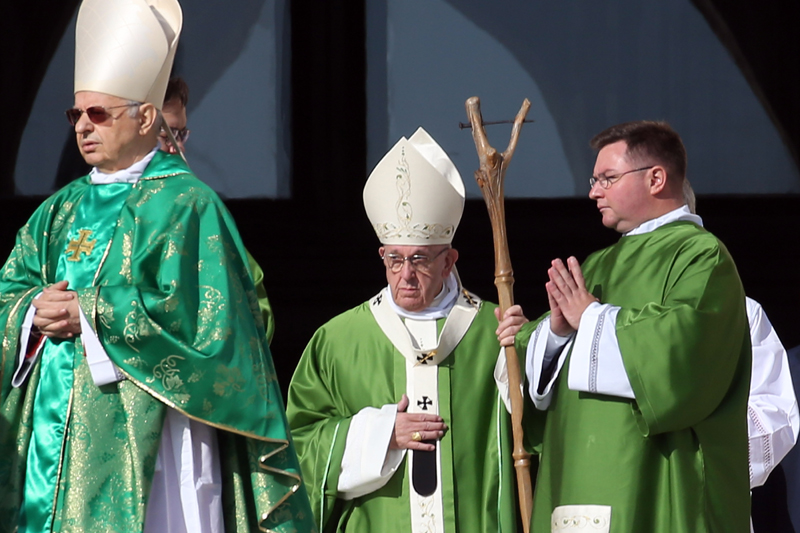
This
is not the first time that Pope Francis sends ambiguous symbolic
messages, through acts, gestures, and attitudes, to the point that one
could ask whether, given these messages’ ambiguity, Francis is not
abandoning his Petrine mission to confirm his brothers in the faith.
© Franco Origlia/Getty Images News/Getty Images
© Franco Origlia/Getty Images News/Getty Images
Since, as Saint Robert Bellarmine states, “the whole Church always taught in words and examples,”5 what did the Pontiff intend to teach through this gesture? That all religions are good, even those that worship “The Horned One”?
Did he intend to consecrate, in a symbolic fashion, the naturalist-ecologist doctrine contained in his encyclical Laudato Si,6 in which he affirmed that the Son of God has “united himself to this earth,”7 that the Holy Spirit is “present at the very heart of the universe,”8 and that the Holy Eucharist is “a fragment of matter”?9
That is why the Divine Master ordered His Apostles to be entirely accurate: “Let your speech be yea, yea: no, no: and that which is over and above these, is of evil”(Matt. 5:37).
May the Virgin Mother of Jesus Christ, the Mother of the Church, His Mystical Body, obtain from her Son that the passion the Church is going through may end as soon as possible.
Pope Francis blesses pagan Pachamama statue in Vatican Gardens
https://veritas-vincit-international.org/2019/12/12/pope-blesses-pachamama/
Below are screen grabs of video footage of the entire proceeding, as well as various photos:















A shaman visits Francis at the Vatican and works her sorcery during a private audience
https://callmejorgebergoglio.blogspot.com/2017/02/a-shaman-visits-francis-at-vatican-and.html
Friday, February 24, 2017
Earlier last week at the Vatican, Francis had a private audience with ‘indigenous peoples’ who were attending the United Nations’ Third Global Meeting of the Indigenous Peoples’ Forum for Investing in Rural People organized by the International Fund Agricultural Development (IFAD) in Rome, Italy. When they were assembled for this private audience, Francis delivered a speech, then went around the room and personally greeted each attendee. As would be expected with ‘Indigenous Peoples’, and we are using that term very loosely, they practiced a hodgepodge of pagan religions. One encounter Francis had caught our attention. It is shown below.
What is the heck is happening?
Who is this woman and what is she doing? To us at Call Me Jorge...
she appears to be a shaman working some sort of sorcery. Well, we did a
bit of digging around and found out that she is a member of the Amaicha
del Valle settlement in Valles Calchaquíes, Tucumán, Argentina.
A photo from the United Nations’ Third Global Meeting of the Indigenous Peoples’ Forum
for Investing in Rural People organized by the International Fund
Agricultural Development (IFAD) in Rome, Italy.
The two circled people, in the picture above, are from the Amaicha del Valle settlement. The man is Dr. Eduardo Alfredo Nieva and the woman is the one who performed the incantation on Francis. Dr. Eduardo Alfredo Nieva is the commissioner of the Amaicha del Valle settlement. They are holding a bottle of wine because Dr. Nieva runs a community winery (Sumak Kawsay means ‘good living’ in the Quechua tongue and is precept of the Pachamama religion) which he started with the help of one of Francis’ favorite pet causes, micro-usury. During this trip to Rome, Dr. Nieva helped secure an additional 50 million dollar loan to the people in rural Argentina. He also gave a bottle of Sumak Kawsay to Francis when they met (see video below, It’s pagan day at the Vatican!).
As you can see, it’s the same woman.
The people of the Amaicha del Valle settlement are pagans as they believe in a multitude of gods. The four gods of primary importance are the husband and wife tandem — Pacha Kamaq (creator of the world) & Pachamama (mother earth) — and their two children — Inti (the sun) & Mama Killa (the moon). Every year in the Amaicha del Valle settlement they hold a six day festival for Pachamama the mother earth goddess.
Dr. Nieva participating in the pagan Pachamama ritual.
Dr. Nieva has high hopes for this religious festival, “we are already preparing everything needed for the national holiday of the pachamama that will take place as every year in our central square.” Other than photos, the only reports from the local Tucumán press has been that Francis thanked the two for the visit and the gift, then sent his greetings to the people of the Amaicha del Valle settlement.
It’s pagan day at the Vatican!
So here we have Francis having a private audience with a United Nations’ group. This same United Nations which pushes all sorts of anti-Catholic causes is also selling the belief in pagan deities in their children publications by equating belief in Pachamama as environmentalism. So what do others in the Novus Ordo church think of Pachamama?
On 17 January 2015 in Chile on the occasion of the consecration of the new diocesan bishop of Arica, Bishop Moisés Atisha, after the service in the cathedral finished, all the bishops assisting including the Apostolic Nuncio and the Cardinal archbishop of Santiago poured outside into the area directly in front of the cathedral and participated in Pachamama worship. The Pachamama shaman placed a rug on the ground and proceeded to offer coca leaves, seeds, water and fermented chicha (corn alcohol). These items were being offered to the deities Pachamama (mother earth), Inti (the sun) and the Malkus (mountain spirits). As can be seen from the photos below, the assembled bishops participated in this offering. After the offering was complete the witch then placed multi-colored necklaces onto the bishops.
“What then? Do I say, that what is
offered in sacrifice to idols, is any thing? Or, that the idol is any
thing? But the things which the heathens sacrifice, they sacrifice to
devils, and not to God. And I would not that you should be made
partakers with devils. You cannot drink the chalice of the Lord, and
the chalice of devils: you cannot be partakers of the table of the Lord,
and of the table of devils.”
The witch doctor prepares his offering.
The witch begins his sorcery.
Bishop Cristian Contreras, bishop of Melipilla (Chile), participates in the rituals.
Bishop Atisha, the new bishop of Arica does as well.
Bishop Ivo Scapolo, the Apostolic Nuncio in Chile gets in on the worship.
Bishop Atisha gets his noahide colored necklace.
If one is interested in more photos from this event (click here).
Cardinal Ravasi participating in Pachamama ritual in 2015
Did these prelates tell Francis of their participation in the pagan Pachamama rituals and rave over them? Or maybe Francis has a deeper connection to this pantheistic gnostic religion back to when he was Jorge Mario Bergoglio in Argentina?
In his address to Representatives of Indigenous Peoples, (15 February 2017) at the private audience he said, “I believe that the central issue is how to reconcile the right to development, both social and cultural, with the protection of the particular characteristics of indigenous peoples and their territories. This is especially clear when planning economic activities which may interfere with indigenous cultures and their ancestral relationship to the earth.” Is this not a clear endorsement of non-Christian religions?
Francis continued later, “A second aspect concerns the development of guidelines and projects which take into account indigenous identity, with particular attention to young people and women; not only considering them, but including them!” Francis then proceeded to put his money where his mouth was by having the female shaman work her ‘magic’ on himself.
Regardless it’s obvious, when one looks at the photos below, that not only does Francis have a deep respect for the pagan Pachamama religion, he like his bishops is an enthusiastic believer in “sitting at the table of devils.”
Below are some and we stress this is only a small sampling of the photos available from the L'Osservatore Romano’s photographic service database for this pagan sorcery ritual.
(To see all the photos, click here.)
(click photos to enlarge)
The wine hand off goes down.
Nice to meet you can I work some ‘magic’ on you?
This is amusing.
She’s feeling a spirit.
That’s not “patty-cake, patty-cake, baker’s man” being played!
She’s communing with the spirit of Vatican II.
Francis is really getting into this sorcery thing, look at the concentration on his face!
She’s channeling another spirit into his head.
It’s crowded in that fat body.
The possession is almost complete!
Uh oh, the spirit is trying to escape through his ears.
She’ll hold this pose for some time.
Whatever she’s doing it’s serious.
She’s using all her shaman abilities now!
More incantations...
Final instructions to the spirit.
Waking Francis from his trance.
The spirit says thanks for the new body.
The sorcery is complete.
Francis the rabbinical traditionalist goes onto the next pagan.
POPE FRANCIS AND THE DEVIL'S HORNS
THE HORNS, THE POPE, and HELEN KELLER
written by Agnes MJ

 After having bumped into the images displaying Pope Francis
making the "horns sign" on January 17 while visiting the Philippines,
and having found myself both in shock and dismay, I decided to dive into
this subject in
the attempt to research its origin, especially since the idea of the
rock gesture of the devil horns seems to be commonly interpreted as a
way to say "I Love You". What is often used as an explanation for this hand symbol is the misplacement of sign language. Originally, in the beautiful sign language there was no inclusion of the "cornuto" gesture; it was simply not part of it. Many ignore, or might want to ignore, the fact that several of these "language signals" (among which we have the horns sign) were developed by the theosophy practitioner, spiritist and medium HELEN KELLER (1880-1968).
After having bumped into the images displaying Pope Francis
making the "horns sign" on January 17 while visiting the Philippines,
and having found myself both in shock and dismay, I decided to dive into
this subject in
the attempt to research its origin, especially since the idea of the
rock gesture of the devil horns seems to be commonly interpreted as a
way to say "I Love You". What is often used as an explanation for this hand symbol is the misplacement of sign language. Originally, in the beautiful sign language there was no inclusion of the "cornuto" gesture; it was simply not part of it. Many ignore, or might want to ignore, the fact that several of these "language signals" (among which we have the horns sign) were developed by the theosophy practitioner, spiritist and medium HELEN KELLER (1880-1968). Keller's background is rather interesting: she was a devoted student of spiritist and false mystic Emanuel Swedenborg (1688-1772). As a tribute to him, she wrote the book "Light in my Darkness", which was originally printed under the title "My Religion" in 1927.
Keller's background is rather interesting: she was a devoted student of spiritist and false mystic Emanuel Swedenborg (1688-1772). As a tribute to him, she wrote the book "Light in my Darkness", which was originally printed under the title "My Religion" in 1927.In the book she declared that "…the teachings of Emanuel Swedenborg have been my light, and a staff in my hand and by his vision splendid I am attended on my way". Emanuel Swedenborg was excommunicated by the same Lutheran Church he was part of. Among his many controversial positions were that the Second Coming of Jesus Christ had already taken place in the past.
To understand the degree of Swedenborg's influence in society, we can see the considerable amount of public figures who, besides Keller, supported him. Among them there are Johnny Appleseed, Honoré de Balzac, Charles Baudelaire, Henry Ward Beecher,William Blake, Elizabeth e Robert Browning, Thomas Carlyle, S. T. Coleridge, Ralph Waldo Emerson, George Inness, Henry James Sr., C.G. Jung, Fitz Hugh Ludlow, Coventry Patmore, Goethe, J.L. Borges, and James Tyler Kent.
In regards to Swedenborg and Theosophy, the Theosophical Society of England stated that "the modern revival of esoterism ranges from the romantic philosophy of the XIXth Century occultism (which involves the so-called Swedenborgism) to bio-magnetism, spiritism, the ancient traditional wisdom, the ceremonial magic, and the para-masonic orders".

 Besides
her devotion to Emmanuel Swedenborg, Helen Keller was deeply involved
with occultist, spirit medium, and Theosophical Society co-founder Madame Helena Petrovna Blavatsky who said that "Satan is the only god of this planet". Keller was very much taken by the writings of Alexander Graham Bell who in his book My Religion explained about his occult religion and writes that "the
celestial Virgin is the Mother of the gods and the demons; because she
is the beneficial and loving divinity…Truly, in ancient times, her name
was Lucifer or Luciferius. Lucifer is the divine and the earthly Light,
the 'Holy Spirit' and 'Satan' both at the same time."
Besides
her devotion to Emmanuel Swedenborg, Helen Keller was deeply involved
with occultist, spirit medium, and Theosophical Society co-founder Madame Helena Petrovna Blavatsky who said that "Satan is the only god of this planet". Keller was very much taken by the writings of Alexander Graham Bell who in his book My Religion explained about his occult religion and writes that "the
celestial Virgin is the Mother of the gods and the demons; because she
is the beneficial and loving divinity…Truly, in ancient times, her name
was Lucifer or Luciferius. Lucifer is the divine and the earthly Light,
the 'Holy Spirit' and 'Satan' both at the same time."Therefore, how can we verify that such gesture is therefore falsely representing the meaning of "I love you". It is absurd that such a well-know satanic sign reminiscent of Baal, of Lucifer, of the Goat, can be universally excepted as a sign of love, especially by a Pope. It is also absurd that people are willing to use it outside of the sign language to allegedly greet the crowds, especially because depending on the country and culture, the horns stands for different concepts such as malediction, black spell, superstition, and adultery.
 The
ridiculous nature of the excuses used to defend the abominable use of
Satan's main hand sign displayed by so-called "pope" Francis amounts to
indescribable degrees. Indeed, many will be those who have theorized
that in the Philippines the devil's sign means "love" due to Ryzza Mae Dizon, a famous child actress who was told to make that gesture as a sign meaning "sad isn't allowed, always be happy".
Indeed, we know that nothing is allowed on national television without
the approval and/or the push of the controlling global elite. Again, the
sign made famous by this infant-instrument of mass brainwashing
supposedly means "being sad is not allowed" (bawal ang sad),
but no one has come to justifying the completely unrelated connection
between such message and the horns of the devil. What seems most logical
is that the masonic/satanic people behind this idea stole the concept
from the already mentioned American sign language and gave it a slightly
different spin. On top of it, they used a little girl to mask the evil
behind the idea just as they can cover a wolf with sheep's clothing.
The
ridiculous nature of the excuses used to defend the abominable use of
Satan's main hand sign displayed by so-called "pope" Francis amounts to
indescribable degrees. Indeed, many will be those who have theorized
that in the Philippines the devil's sign means "love" due to Ryzza Mae Dizon, a famous child actress who was told to make that gesture as a sign meaning "sad isn't allowed, always be happy".
Indeed, we know that nothing is allowed on national television without
the approval and/or the push of the controlling global elite. Again, the
sign made famous by this infant-instrument of mass brainwashing
supposedly means "being sad is not allowed" (bawal ang sad),
but no one has come to justifying the completely unrelated connection
between such message and the horns of the devil. What seems most logical
is that the masonic/satanic people behind this idea stole the concept
from the already mentioned American sign language and gave it a slightly
different spin. On top of it, they used a little girl to mask the evil
behind the idea just as they can cover a wolf with sheep's clothing.  We
do not mean to attack the little girl, for she is not, by any means, a
Satanist. Rather, it is those who have decided to use her for the
purpose of ingraining such ridiculous concept in people's minds. It
would be enough to see the terrorized face of the infant (in the
photograph on the left) to realize that these public displays are just
as fake as the entire television productions all these people work on.
We
do not mean to attack the little girl, for she is not, by any means, a
Satanist. Rather, it is those who have decided to use her for the
purpose of ingraining such ridiculous concept in people's minds. It
would be enough to see the terrorized face of the infant (in the
photograph on the left) to realize that these public displays are just
as fake as the entire television productions all these people work on.At this point, I dare to speculate on this scenario as if voicing my inner thoughts out loud: could it be possible that all this girl was used for is the day on which this "pope" would display that gesture in Manila? After all, the girl came into fame only in 2012, only about a year before Jorge Mario Bergoglio was illegitimately elected as "vicar" of Our Lord, Jesus Christ.
Secret groups work patiently, cunningly, and well in advance. They plan their moves carefully so as to not make any mistakes; every detail is being cared for because these architects use their compasses and squares to reach the perfect degree for every angle.
And since only God can make things perfect, we decided to look for some possible tiny errors they might have missed on by visiting little Ryzza's Twitter page.
What we have found is the usual image of "pope" Francis and Cardinal Tagle blatantly letting the awaken ones know who their true master is. We have inserted the actual screenshot of her page, where you will find a brief exchange between two young people (one of whom inserted a link to Wikipedia explaining what this sign truly represents). We have then added a partial (partial for image size issues) screenshot of that same Wikipedia article. Above that, we have written a short evaluation, which we will retype right next to the following picture:
 In this image, our friend Ryzza – or rather the corporation writing this tweet on her behalf – is telling us that “pope” Francis is using the horns to say "sad isn't allowed, always be happy", which is what many supporters of the False
In this image, our friend Ryzza – or rather the corporation writing this tweet on her behalf – is telling us that “pope” Francis is using the horns to say "sad isn't allowed, always be happy", which is what many supporters of the FalseProphet have used to justify his action.
What is strange is that we all thought the “pontiff” was actually communicating “love” to the present deaf people in the audience.
Therefore, which of the two theories is valid? The devil horns for BE HAPPY? Or the devil horns for I LOVE YOU?
We have the correct answer for you: neither formula is true, for what Bergoglio meant to do is simply what you see: the honoring of the beast through that DEVIL SIGN known for being such since the remoteness of the yesterdays (as you can see in the Wikipedia image on the left).
The other two meanings are only working as 'shields' used by the Illuminati to allow this scandalous symbol to sneakily continue to spread.
It should be enough to just see the discouraging amount of celebrities honoring the goat to understand the acceptance level of this dark sign in today's society. If you believe a crucifix to be any more acceptable a sign than the goat's, then you need to open your eyes and look in the right direction, my friends. As for the cases of this "pope" and little Ryzza, are we still believing the illusions of show business? Are we still willing to permit the controlling media to brainwash us, even though the amount of alternative information available today is constantly increasing? How could we ever allow ourselves to accept this satanic symbol to be practiced by a pope?
Indeed, this hand sign is ancient. Today, neo-pagans utilize it to represent the "horned god" in order to identify each other; therefore, in this specific context, this hand-logo is defined as the sign of the horned god of which counterpart is the fig sign. Some believe that it is meant to bestow the evil eye, while in other cases it is used for the explicit representation of the Devil in Satanism. The gesture's roots are thought to be strictly connected to the image of the goat's head as the hand is reproducing the triangular shape of the devilish animal. We must also underline that the goat's head is not only a Christian symbol, but often it is seen in other religions, one of which is Islam.
Here, below, is our video briefly exposing the shocking issue of a Catholic "pope" making the outrageous sign of Satan. Let us all meditate on one fact: imagine what would have happened if a Pope had made such public gesture up until fifty years ago. We believe that such person would have immediately been taken away from his current position as head of the Holy Catholic and Apostolic Church.
ORIGIN OF THE HORNS

A 14th Century Arabic manuscript illustration. Obviously this devil is not signing "I Love You."
Those who use these hand signs to communicate among themselves should prevent themselves from taking part of any discussion in regards to the same, even for the sake of simple respect. Not to mention the continuous and widespread need to justify this dark homage through excuses and reasoning processes of all kinds. It should be enough to see the examples of Heavy Metal, Rock and Pop music, which have had an immense influence on its propagation among the youth; even actors are being caught with their hand in the sugar box. And what is most shocking is seeing politicians do the same. Now even the Pope: the very representative of Love, it being Jesus Christ, displays a non-Catholic symbol of a false love, the one of Lucifer. As we saw, the root of that muted hand symbol is rooted in Theosophy, the cult of Satan, New Age, Free Masonry and New Wicca: all factions which hate God and His Holy Word as they instead wait for the 'new messiah', the New World Order, the New Order of the Age.
 It is also interesting to consider that in French "I LOVE YOU" has different initials which make no horns. "Je t'aime" in French, "Te amo" in Spanish, "愛しています" in Japanese, or "Mahal kita" in Filipino will not present an "I", an "L" and an "Y" as initials. The letters "I", "L", and "Y" are only meant for the English language which is not spoken in the Philippines.
It is also interesting to consider that in French "I LOVE YOU" has different initials which make no horns. "Je t'aime" in French, "Te amo" in Spanish, "愛しています" in Japanese, or "Mahal kita" in Filipino will not present an "I", an "L" and an "Y" as initials. The letters "I", "L", and "Y" are only meant for the English language which is not spoken in the Philippines. Again, like in the case of the young Rizza Mae Dizon, photographed on the left with the same horns which supposedly represent "love", the logic behind this theory does not support the results. This image clearly portrays a girl who not only does not hint to any sort of joy or happiness typical of girls her age, but is displaying a costume that certainly recalls the witches of old.
The two horns are made by two black swans, which are very meaningful hermetic symbols utilized in several rituals as they are known to have been the seal of the occult-obsessed and Satanist Catherine de Medici, a powerful Italian noblewoman who became Queen of France from 1547 to 1559.
These two figures also appear in the notorious ballet Swan Lake in which the black swan, symbolizing the negative female energy, kills the white swan, symbolizing the positive. The closest paralell we can find is in the story of Hecate killing Diana.
A swan is a derogatory term in Druidism, and it stands for the dark and occult side of fame, for duality, for trauma-based mind control, and the forced creation of an alter persona (among other things).
Curious facts:
William Gibson wrote a play (from which a movie will be made) by the name of The Story of My Life, the 1902 autobiography of Helen Keller.
The Helen Keller Hospital in Sheffield, Alabama, is dedicated to her.
A stamp was issued in 1980 by the United States Postal Service depicting Keller and Sullivan, to mark the centennial of Keller's birth.
There are streets named after Helen Keller in Zürich, Switzerland, in Getafe, Spain, in Lod, Israel, in Lisbon, Portugal and in Caen, France.
On October 7, 2009, a bronze statue of Helen Keller was added to the National Statuary Hall Collection, as a replacement for the State of Alabama's former 1908 statue of the education reformer Jabez Lamar Monroe Curry.
 As
we have mentioned already, what true Christians believe is that Jesus
Christ Is love. Therefore, the very symbol of love is Christ Jesus. And
since the apex of Christ's display of love is the act of Self-Sacrifice
He Made for the redemption of the world and the salvation of those who
will follow Him, the Crucified Christ is what symbolizes love in our
faith. Such truth is represented in what has been called 'crucifix' for a
very long time. The crucifix is an extremely important Catholic object,
for it defines, reminds and displays to us as well as to others what is
the essence of our beings. Just like a mark, a 'spiritual' passport or a
wedding band, it expresses who our bodies, minds and souls belong to.
For this reason – as well as for protection against all evil – we wear
the crucifix around our necks. This most precious object is also found
in churches everywhere around the world, in the Holy Rosary, in
cemeteries, in monasteries and in convents. The man who goes by the
title of "pope" Francis has already displayed a behavior of censorship
towards the holy cross.
As
we have mentioned already, what true Christians believe is that Jesus
Christ Is love. Therefore, the very symbol of love is Christ Jesus. And
since the apex of Christ's display of love is the act of Self-Sacrifice
He Made for the redemption of the world and the salvation of those who
will follow Him, the Crucified Christ is what symbolizes love in our
faith. Such truth is represented in what has been called 'crucifix' for a
very long time. The crucifix is an extremely important Catholic object,
for it defines, reminds and displays to us as well as to others what is
the essence of our beings. Just like a mark, a 'spiritual' passport or a
wedding band, it expresses who our bodies, minds and souls belong to.
For this reason – as well as for protection against all evil – we wear
the crucifix around our necks. This most precious object is also found
in churches everywhere around the world, in the Holy Rosary, in
cemeteries, in monasteries and in convents. The man who goes by the
title of "pope" Francis has already displayed a behavior of censorship
towards the holy cross. 
Move over, Harry Potter…
It’s a Stang: Francis opened Vatican Youth Synod with Sorcerer’s Staff
A few days ago we reported on Francis’ opening of the Youth Synod in the Vatican, which is scheduled to conclude on Oct. 28. The pastoral staff, called a ferula, that Francis used represented a new low in post-Vatican II liturgical absurdity. We commented that it looked like a hybrid between a slingshot and a barbecue fork, and indeed it does. However, research by others has now brought to light that this “thing” is more than just another Modernist piece of junk — in fact, it is downright Satanic.To get straight to the point: The staff Francis used is a so-called stang. A stang is basically a sorcerer’s ritual staff used in modern-day witchcraft (Wicca). It had been presented to him on Aug. 11 of this year during a meeting with young Italians at Rome’s Circus Maximus. The video of the occasion is embedded here (the stang is presented to him beginning at the 15:19 min mark):
The following is a close-up of the top of the staff, taken from the video above. It looks as though there is a face carved into the bump, and there clearly are engravings in the two horns.

- “Satanists Manifesting: Antipope Bergoglio Carries a Stang – the Ritual Staff of Witchcraft” (Barnhardt)
- “Wiccan Stang Given to Antipope Bergoglio By Woman Wearing Wiccan Red String Bracelet” (Barnhardt)
- “Youth Synod starts under the symbol of witchcraft” (Tradition in Action)
- “So…Did the Pope Carry the Satanic Stang at the Opening Mass of the Youth Synod?” (Les Femmes – The Truth)
- “Jeepers, Creepers, Where’d You Get That Stang?” (Mahound’s Paradise)
- “Sobre el Báculo de Bergoglio el Brujo” (Miles Christi)
- “The Stang” (Patheos: By Athame & Stang **caution, this is a Wiccan blog**)
One very important detail that is not to be glossed over is that the young woman who gave the stang to Francis on Aug. 11 was wearing a red wristband, another occult symbol, as shown in Barnhardt’s second post linked above.
Of course, many people will now say that we cannot assume that Francis knowingly used a Wiccan wizard’s staff for a ferula. Aside from the fact that no one in his right mind would use such a piece of sinister-looking junk in place of the Cross of Christ, it is Francis’ obligation to know what he is using. The burden rests on him to ensure he acts in accordance with the Faith at all times, not on everyone else to constantly find excuses for him. Even more importantly, however, we must point out that for Francis to knowingly use a witches’ staff in the liturgy totally fits the pattern we have seen from him over the years.
Let’s review: Francis has said he has so much energy because instead of going to the doctor, he goes “to the witch”; he has literally stated, “I am the devil”; when receiving a Pagan sorceress at the Vatican, he allowed her to work some of her magick on him; he has stated that his favorite exorcist is a Lutheran layman; he has received a large number of “medical” treatments by a practitioner of Taoism; he has said that Jesus Christ “made Himself the devil” for us; he has given a manuscript of the life of Buddha as a gift to the president of Myanmar; he is on record saying that Pagans “meet God in different ways”; he has kissed a sinister-looking crucifix with occult symbolism; he has paid a visit to Buddhist “relics”; decades ago he sought prolonged professional help from a Jewish psychoanalyst; he continually holds audiences before the blasphemous “Resurrection” sculpture in the Paul VI audience hall; he cracks blasphemous jokes; and he has declared the ultimate Witchdoctor of the Novus Ordo Church, “Pope” John Paul II of Voodoo, cow dung, Koran-kissing, and Assisi interfaith prayer infamy, to be a “saint” worthy of Catholics’ veneration and imitation.
The real question, therefore, is: Why wouldn’t he use a Wiccan stang?
At this point, the Great Apostasy is so far advanced that the “Pope” can use a two-horned staff that is clearly linked to witchcraft, and except for a select few bloggers, practically nobody cares. If soon there is open Satanism being practiced in the Vatican, it will barely elicit a yawn. For his next “Mass”, expect to see a pitchfork or a broomstick.
Two-thousand years ago, St. Paul asked rhetorically: “And what concord hath Christ with Belial?” (2 Cor 6:15). But then again, that was before Vatican II.
Francis Brings Back “Bent Cross” Crozier
It was just a matter of time…
Francis Brings Back “Bent Cross” Crozier
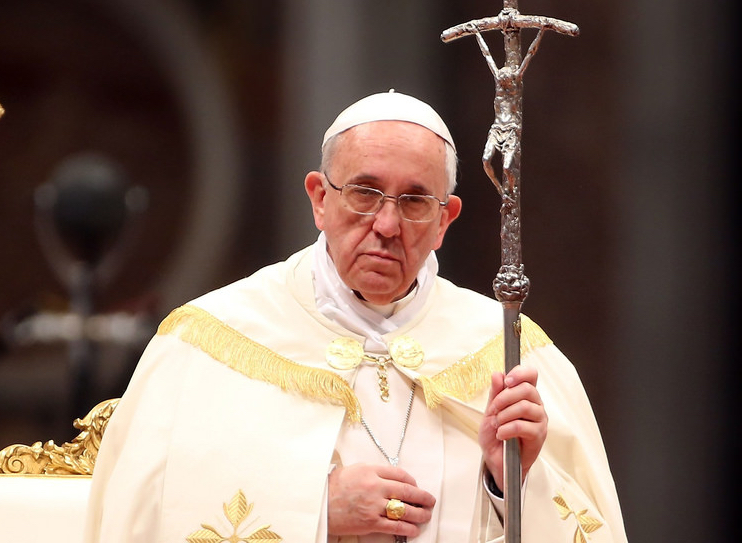 It was bound to happen. Mr. Jorge Bergoglio — whom the world calls
“Pope Francis” — has reintroduced the repulsive ‘Bent Cross’ Crozier
(sometimes referred to as the “Broken Cross”), after Benedict XVI had,
for the most part, abandoned it. The indult blog Rorate Caeli has the story.
It was bound to happen. Mr. Jorge Bergoglio — whom the world calls
“Pope Francis” — has reintroduced the repulsive ‘Bent Cross’ Crozier
(sometimes referred to as the “Broken Cross”), after Benedict XVI had,
for the most part, abandoned it. The indult blog Rorate Caeli has the story.The “bent cross” ferula, or staff, which is a hideous rendition of a crucifix, shows our Lord’s legs immodestly spread apart and shows the cross bars bent, rather than straight. The following photos show that this “crucifix” is repulsive indeed, dishonors Christ, and does not inspire pious thoughts:
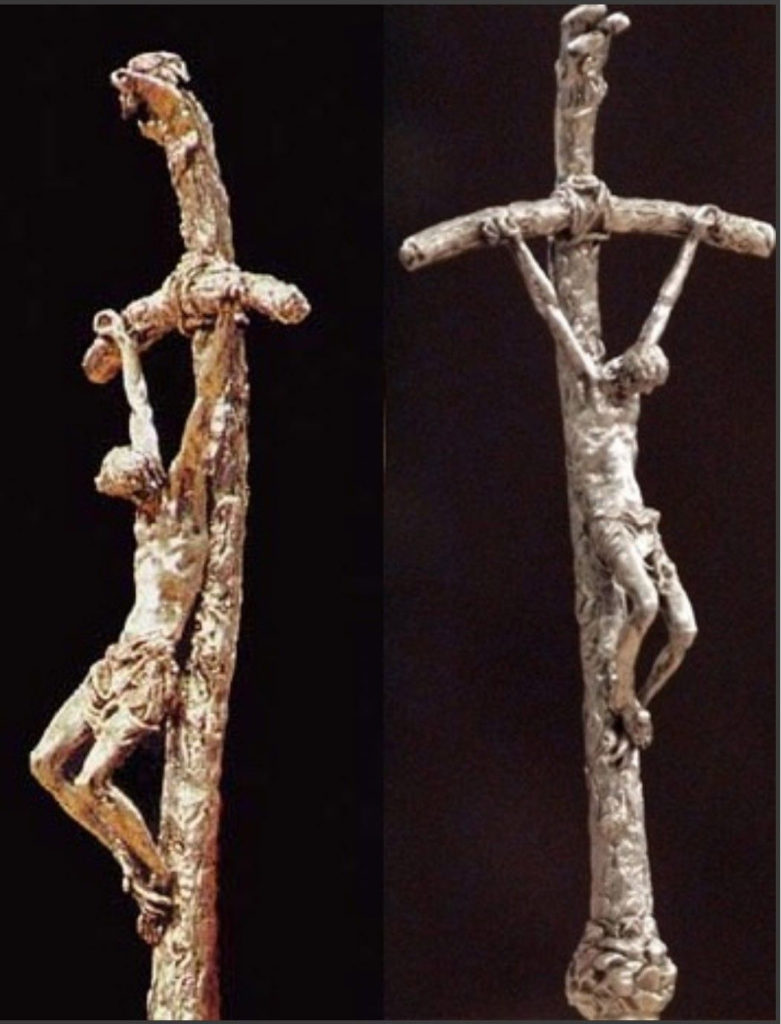
The blasphemous Scorzelli cross bears some striking resemblance to the the crucifix drawn by Belgian “artist” Albert Servaes (d. 1966) as part of his “stations of the cross”, which were condemned by the Church in 1921 under Pope Benedict XV (see here). Notice in particular the hanging head and the bent legs:
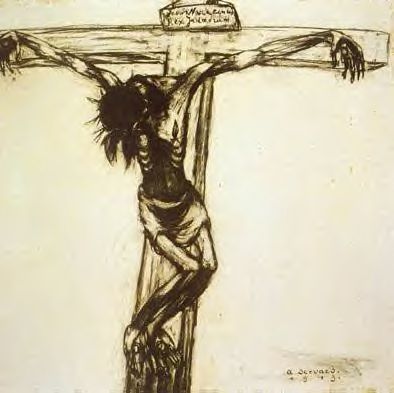
Striking Resemblance to the Scorzelli Cross:
“Crucifixion” by Servaes, condemned by the Holy Office in 1921
“Crucifixion” by Servaes, condemned by the Holy Office in 1921
(The full decree of the Holy Office condeming these drawings, dated March 30, 1921, can be found in the original Latin here.)
On September 11, 1670, under Pope Clement X, the Holy Office
prohibited the making of crucifixes “in a form so coarse and artless, in
an attitude so indecent, with features so distorted by grief that they
provoke disgust rather than pious attention” (quoted by Jacques
Maritain, Speech to Journées d’Art Religieux,
Feb. 23, 1924). The reason for this prohibition has never been more
obvious than now, now that the Vatican II Church has spent decades
disregarding this decree and has commissioned, promoted, allowed, and
tolerated the foulest modernistic displays of religious “art” around the
world.In addition, the indecent Scorzelli crucifix also has something in common with the heretical crucifixes of the Jansenists:

Jansenist Altar Crucifix (heretical and condemned)
When Paul VI died in 1978, his successor John Paul I retained the ferula, and John Paul II used it pehaps more frequently than anyone else. Benedict XVI used it as well, though not as often. More images can be found on Pinterest.
Tragically, the hideous Scorzelli cross is
also attached to many Rosary beads among Novus Ordos, and probably even
some traditional Catholics unwittingly use it, not realizing what an
affront to Our Lord it is.
So...Did the Pope Carry the Satanic Stang at the Opening Mass of the Youth Synod? https://lesfemmes-thetruth.blogspot.com/2018/10/sodid-pope-carry-satanic-stang-at.html
Check out Susan's post and compare the pope's ferula (which differs from a bishop's crozier which is shaped like a shepherd's crook and is usually a ball with a cross) to the satanic stang. Hmmm....Sure looks like a stang doesn't it! Ann Barnhardt has a chilling article about the stang and the pope's use of it here. Of course the youth who gave it to the pope had a different explanation for it, (Surprise!) but that would be expected wouldn't it? The devil can appear as an angel of light.
